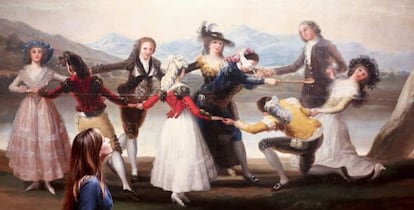Prado Museum unravels Goya¡¯s neglected tapestry sketches
Madrid show offers insight into overlooked part of Spanish master¡¯s output


In 1774, at the age of 28, having already made a name for himself in his native Zaragoza and traveled throughout Italy, Francisco Goya moved to Madrid at the invitation of German painter Anton Raphael Mengs. There he would spend the next five years working mainly for the Royal Tapestry Factory, producing huge sketches, or cartoons: preliminary paintings for tapestries that would hang on the walls of two royal residences, the Escorial monastery and the Pardo palace. Goya would continue working with the Royal Tapestry Factory on and off for the next two decades, producing around 63 cartoons at the same time as establishing his position as painter to the Spanish court.
Taking advantage of refurbishment work in the second-floor galleries of the Prado Museum¡¯s south wing that house Goya¡¯s cartoons and part of its collection of 18th-century Spanish paintings, the Prado has organized Goya in Madrid, an exhibition of the cartoons scheduled to run in its temporary exhibition galleries until May 3.
These are not simply templates for tapestries, but complex masterpieces in their own right¡± Prado director Miguel Zugaza
Miguel Zugaza, the Prado¡¯s director, says the exhibition shows the cartoons as works of art: ¡°These are not simply templates for tapestries, but complex masterpieces in their own right,¡± he says.
The exhibition¡¯s curators, Manuela Mena and Gudrun Maurer, have brought together the series ¨C which is not complete: El pelele (The straw mannequin) and El alaba?il (The laborer) are on loan ¨C across 15 rooms. The works explore a number of themes: hunting, dreams, the four seasons, music and dance, childhood, and the open air, which is underscored in the final gallery by a background recording of the wind.
Multimedia approach
Among the many surprises awaiting visitors to the Goya in Madrid exhibition is the inclusion of the hunting scenes from French filmmaker Jean Renoir's 1939 comic masterpiece La R¨¨gle du jeu. Zugaza says this marks the first time that film has been used in a Prado exhibition. The snippets sit perfectly with Mariano Nani's Kitchen Still Life with a Hare and Two Partridges and Paul Vos's Fable of the Fox and the Herons.
The exhibition also uses music and sound to put Goya's cartoons into context. Touch screens interspersed throughout the exhibition allow visitors to hear music from Goya's time, as well as more modern compositions such as Christos Tsitsaros' Echoes from an Arena, and Rossini's Comic Duet for Two Cats, the perfect backdrop for Goya's Cat Fight, as well as Mozart's Sleigh Ride, which provides a musical setting for The Snowstorm.
The freshness, realism, and imagination of Goya¡¯s work is illustrated by the inclusion in the exhibition of pieces by his contemporaries at the Royal Tapestry Factory, including Mariano Salvador Maella, Luis Paret, Mat¨ªas T¨¦llez, and the Bayeu brothers, Francisco and Ram¨®n, to whose sister, Josefa, Goya was married.
The exhibition also highlights some of the influences Goya took from the great masters. The use of mythological figures in La gallina ciega (The blind hen) from 1778 draws on Rubens¡¯ Dance of Italian Villagers, which is placed next to it, while the posture of the figure in the foreground of Partida de caza (The hunt begins) from 1775, has echoes of Jacques Saly¡¯s 1751 sculpture Faun Holding a Goat. Goya¡¯s figure of a young man smoking in El juego de pelota a pala (Bat and ball game) was possibly inspired by one of Michelangelo¡¯s portraits of Lorenzo de Medici, says Mena.
She added that the huge cartoons ¨C rich in detail, multilayered, and making use of perspective to invite the viewer into the center of the composition ¨C are proof that Goya was ¡°much more than just a recorder of the traditions and daily life of the people of Madrid¡± and that these pieces are works of art.
Portraits of Felipe IV, Carlos III and Carlos IV, painted as hunters by Vel¨¢zquez, Goya, and Mengs, welcome visitors into the world of mid-18th century Spain. The cartoons were commissioned by the Royal Household and were then converted into tapestries that were used as visual metaphors for how they intended to rule: good government was associated with the hunt, while reforms were illustrated by games. The exhibition also draws on the benchmark biography of Goya by Janis Tomlinson, using part of her text to explain how the painter came to live in Madrid, and the circumstances that led to him being commissioned to create the cartoons.
Hunting is the subject of many of the cartoons seen in the exhibition. Among the highlights is Cazador cargando su escopeta (Hunter loading his shotgun), which Ram¨®n Bayeu had left unfinished. This has been restored as Goya would have conceived it, with the part added in 1933 ¨C at which time it was believed to be entirely Bayeu¡¯s work ¨C now removed.
Goya en Madrid. Until May 3 at Museo Nacional del Prado, Paseo del Prado, s/n, Madrid. www.museodelprado.es
Tu suscripci¨®n se est¨¢ usando en otro dispositivo
?Quieres a?adir otro usuario a tu suscripci¨®n?
Si contin¨²as leyendo en este dispositivo, no se podr¨¢ leer en el otro.
FlechaTu suscripci¨®n se est¨¢ usando en otro dispositivo y solo puedes acceder a EL PA?S desde un dispositivo a la vez.
Si quieres compartir tu cuenta, cambia tu suscripci¨®n a la modalidad Premium, as¨ª podr¨¢s a?adir otro usuario. Cada uno acceder¨¢ con su propia cuenta de email, lo que os permitir¨¢ personalizar vuestra experiencia en EL PA?S.
?Tienes una suscripci¨®n de empresa? Accede aqu¨ª para contratar m¨¢s cuentas.
En el caso de no saber qui¨¦n est¨¢ usando tu cuenta, te recomendamos cambiar tu contrase?a aqu¨ª.
Si decides continuar compartiendo tu cuenta, este mensaje se mostrar¨¢ en tu dispositivo y en el de la otra persona que est¨¢ usando tu cuenta de forma indefinida, afectando a tu experiencia de lectura. Puedes consultar aqu¨ª los t¨¦rminos y condiciones de la suscripci¨®n digital.








































